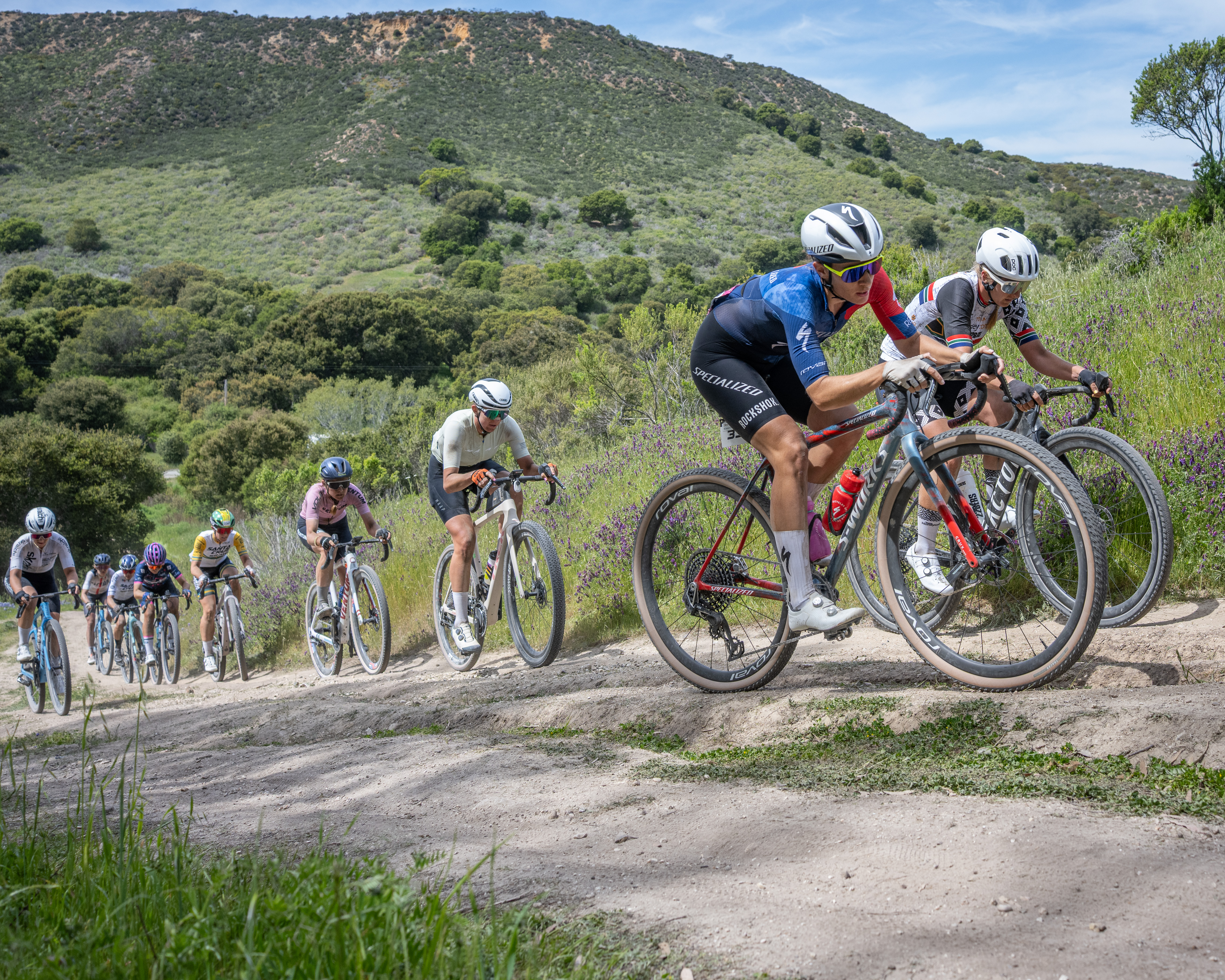Drawing a line in the gravel - Will anti-drafting rules create structure or friction in Life Time Grand Prix competitions?

The elite women's field, no men in sight, on one of the sandy climbs at 2025 Sea Otter Classic Gravel Last year, I was part of a group of elite women who had a series of video conference calls with the Life Time Grand Prix organizers to discuss improving fairness for the elite women during competitions. We kicked around ideas like increased staggered start times and, yes, anti-drafting rules. The idea was to reduce the interference from the men’s fields (both elite and amateur) and create something closer to an actual women's race. Life Time held off implementing anti-drafting rules last year in order to better define regulations and address implementation, as it would be a giant lift across multiple events, courses, and rider categories. But they did increase the start time gaps: at last year’s Unbound Gravel 200, the elite women started 15 minutes after the elite men, and 20 minutes before the amateurs. That may not sound like much, but it was a solid tweak, which delivered the first-ever women’s sprint finish at Unbound 200 among nine elite riders at the race. Fast-forward to the week before the 2025 Sea Otter Classic Gravel, and Life Time casually dropped an email into the inboxes of the Grand Prix riders in the field announcing that anti-drafting rules were officially happening. No warning. No follow-up conference call. No vibe check. Just… boom. Inbox surprise. This is big. It’s the first time a high-profile gravel series is formally regulating drafting. Whether you love it or hate it, we’re watching the sport evolve in real time — and that’s pretty exciting. The rule and enforcement The new rules state that elite women cannot draft off elite men or any amateur riders, and elite men cannot draft off elite women or any amateur riders. It also identifies amateur riders, stating they "may draft off any other Amateur Rider, regardless of that Amateur Rider’s category (Age Group, Single Speed, Male, Female, etc.)". So what is the definition of "drafting"? For Life Tiime, it is being "within 15 feet (or two bike lengths), and 3 feet to either side, for longer than 15 seconds". What if you break the rule? "You’re relegated to last place in the elite results and the LTGP standings for that event". Get The Leadout Newsletter The latest race content, interviews, features, reviews and expert buying guides, direct to your inbox! Contact me with news and offers from other Future brands Receive email from us on behalf of our trusted partners or sponsors How riders be monitored during a race was the biggest question. Here is what Life Time spelled out: Enforcement will come from neutral moto race marshals, course marshals, and Life Time staff who will provide moto, drone, live camera feed, helicopter, and any other verifiable modes of observation evidence, as well as rider feedback, at the discretion of a race jury. *However, Life Time says, "Rider input as verifiable evidence to determine the validity of a violation will NOT be accepted." *So basically, if you see someone cheating and tell the officials, your word alone isn’t enough. They’ll only rely on objective sources like footage and not he-said-she-said stuff from other competitors. In course sections where passing is impossible, logical concessions will be made. For example, single-track sections, climbs, and areas of congestion. Athletes will have 30 minutes from the declaration of a violation to submit an official appeal. When we discussed the rule in 2024, we debated ideas like escalating time penalties for first, second, and even third infractions (which might still be too lenient — I mean, is 5 minutes enough if you gain 20 minutes from sitting on a strong wheel for hours?). So now the penalty is so severe that it removes any incentive to take the risk, which is the point. No warnings. No “hey, don’t do that again.” No slap on the wrist. Just one-and-done relegation. Straight to the bottom of the results sheet. The fear of relegation is real. And maybe that’s enough to shift the culture. Soft launch It was a dusty day for Sea Otter Classic Gravel in Monterey, so not condusive to drafting of any sort (Image credit: Life Time / Dan Hughes) The new anti-drafting policy will be enforced at all six Grand Prix events, and began on April 10 at the Sea Otter Classic Gravel. Did it matter in Monterey? Honestly, not really. The elite fields raced on Thursday and the amateur field on Friday, so that was no issue. Plus, the elite women started 20 minutes behind the elite men on a circuit that didn’t lend itself to drafting. It was punchy, technical, and mostly singletrack — not exactly a place you’re going to tuck in and cruise on some random guy’s wheel. There wasn’t a single instance where I saw someone breaking the rule. That might not always be the case, but at Sea Otter it worked fine. Sea Otter was a soft launch, but Unbound Gravel will be the real test. The elite men will begin the 200-mile course at 5:50 a.m. (CST) from Commercial Street in downtown Emporia, Kansas, on May 31. The elite women will follow 15 minutes later, like last year, and then the mass start for amateurs will be released on the same course 25 minutes after the elite women. Fifteen minutes may feel like a big gap on paper, but it’s a long race. People have flats, mechanical issues, and full-on meltdowns. It’s not hard to imagine an elite man dropping back and 'interfering' with the women’s race. Or a few amateurs with mega-watts can catch dropped riders from the women's elite field and pull them back to the lead group. While I’m glad they bumped the amateur field back 25 minutes — a good move — I still think that timing will be tight. But I get it. People want to finish before the sun sets in Kansas. How enforceable is this? Lauren De Crescenzo rides to ninth overall, eighth among LTGP women, at 2025 Sea Otter Classic Gravel (Image credit: Life Time / Dan Hughes) There are so many nuances, so many what-ifs. And as of now, we’re trusting race juries to make sense of them. There’s going to be trial and error. And probably a few sacrificial lambs along the way. But I give Life Time credit for being willing to try. It’s not easy being the first to put structure into a sport that prided itself on being loose, grassroots, and gloriously chaotic. Life Time is sending a message: they’re serious about fairness, and they’re willing to evolve. That’s worth something. This isn’t just about drafting. It’s about growing pains. Gravel racing is maturing. With prize money, contracts, and sponsorship dollars on the line, structure is inevitable. And sometimes, structure creates friction. We all want a fair race. We want results to come down to fitness, skill, and strategy, not who found the strongest random dude, friend or significant other to sit behind for 80 miles. But gravel is messy. It’s part of why we love it. We’re still defining what gravel is, what we value, and how to protect those values while making room for evolution. This rule is one step in that process. Not the final answer, but maybe a first draft. Is the rule perfect? No. Is it enforceable? TBD. Is it a step in the right direction? Definitely. And just like Lifetime ends their Elite Tech Guide with “Lifetime reserves the right to amend this policy at any time,” I’d like to reserve the right to change my opinion at any time, depending on how all this plays out. Because this is gravel, we’re figuring it out together. One rule change at a time.



















